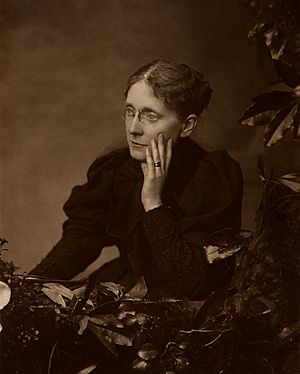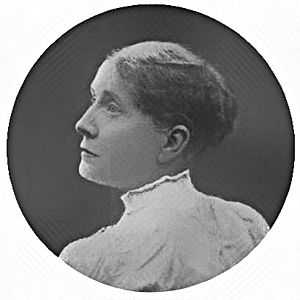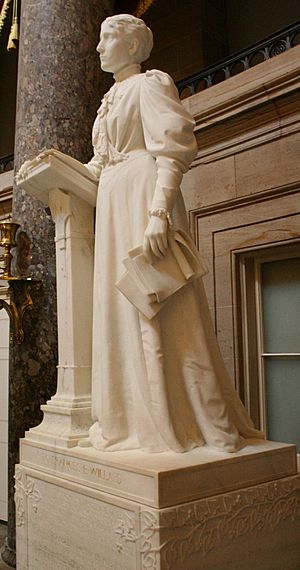Frances Willard facts for kids
Quick facts for kids
Frances Willard
|
|
|---|---|
 |
|
| Born |
Frances Elizabeth Caroline Willard
September 28, 1839 |
| Died | February 17, 1898 (aged 58) New York City, US
|
| Known for | First dean of women, Northwestern University; long-time president, Woman's Christian Temperance Union; founder, World's Woman's Christian Temperance Union; first president, National Council of Women of the United States |
Frances Elizabeth Caroline Willard (September 28, 1839 – February 17, 1898) was an American educator and a strong leader for women's rights. She worked to improve society in many ways. Frances Willard became the national president of the Woman's Christian Temperance Union (WCTU) in 1879. She led this group until she passed away in 1898.
The WCTU was a group that worked to reduce the use of alcohol. Frances Willard created the slogan "Do Everything" for the WCTU. This meant she wanted members to work on many social changes. They did this by talking to lawmakers, asking people to sign petitions, and teaching others. Willard helped pass laws for an eight-hour work day. She also wanted to improve prisons and expand women's rights around the world.
Contents
Early Life and Schooling
Frances Willard was born in 1839 in Churchville, New York. Her parents were Josiah Flint Willard and Mary Thompson Hill Willard. She was named after famous writers. Frances had two siblings, an older brother Oliver and a younger sister Mary.
Her father was a farmer and a lawmaker. Her mother was a schoolteacher. In 1841, her family moved to Oberlin, Ohio. Her father studied to become a minister there. In 1846, they moved to Janesville, Wisconsin for her father's health.
In Wisconsin, Frances and her sister Mary went to Milwaukee Normal Institute. Their aunt taught at this school. In 1858, the Willard family moved to Evanston, Illinois. Frances and Mary attended the North Western Female College.
Becoming a Teacher
After finishing college, Frances Willard taught at different schools. She worked at the Pittsburgh Female College. She also taught at the Genesee Wesleyan Seminary in New York. In 1871, she became the president of the new Evanston College for Ladies.
When this college joined Northwestern University in 1873, Frances Willard became the first Dean of Women. This job did not last long. She left in 1874 after disagreements with the university president.
Leading for Change: WCTU and Women's Rights
After leaving her teaching job, Frances Willard focused on helping women. In 1874, she helped start the Woman's Christian Temperance Union (WCTU). She was chosen as the first Corresponding Secretary. In 1876, she became the head of the WCTU's publishing team. She helped spread the word about the WCTU's newspaper, The Union Signal.
In 1879, Frances Willard became the president of the National WCTU. She stayed president until she died. She worked very hard for the cause. She traveled thousands of miles each year. She gave hundreds of speeches to share her ideas.
Working for Women's Right to Vote
As president of the WCTU, Willard also spoke out for women's right to vote. She believed women should not think of themselves as "weaker." She encouraged women to join the movement to make society better. She famously said, "Politics is the place for woman."
Willard believed that women and men should lead together. She said this was true in homes, schools, churches, and government. She felt that God intended for men and women to work side by side.
In 1888, Willard helped create the National Council of Women of the United States. She was its first president. She also founded the World WCTU in 1888. She became its president in 1893. She worked closely with Lady Isabel Somerset from England.
In 1892, she joined a meeting for the People's Party. She helped write ideas for the party. However, the new party did not support women's right to vote. They wanted to focus on money issues instead. After 1893, Willard became a Christian socialist. This meant she believed in helping people through Christian values and social change.
Death and Lasting Impact
Frances Willard passed away in her sleep in New York City. She had caught the flu while getting ready to travel to England and France. She is buried in Rosehill Cemetery in Chicago, Illinois.
She left her home in Evanston, Illinois to the WCTU. The Frances Willard House became a museum in 1900. It also served as the WCTU headquarters. In 1965, it was named a National Historic Landmark.
Honoring Her Memory
After her death, Frances Willard was the first woman honored in Statuary Hall in the United States Capitol. Her statue was created by Helen Farnsworth Mears. It was shown to the public in 1905.
A famous painting called American Woman and her Political Peers shows Frances Willard. She is in the center, surrounded by people who could not vote. This painting showed that educated women, without the right to vote, were treated like other groups who could not vote.
Many places are named after Frances Willard.
- The Frances Willard House Museum and Archives is in Evanston, Illinois.
- A dormitory at Northwestern University, Willard Residential College, is named for her.
- The Frances E. Willard School in Philadelphia is named after her.
- The Frances Willard Schoolhouse in Janesville, Wisconsin, is also named for her.
- Willard Middle School and Willard Park in Berkeley, California, honor her.
- Frances Willard Elementary School is in Scranton, Pennsylvania.
- Frances Willard Avenue in Chico, California, is named after her.
- The Frances E. Willard Temperance Hospital in Chicago was named for her. It is now Loretto Hospital.
- A small memorial is in Kingston, Ontario, Canada.
Frances Willard was inducted into the National Women's Hall of Fame in 2000.
Images for kids
See also
 In Spanish: Frances Willard para niños
In Spanish: Frances Willard para niños





